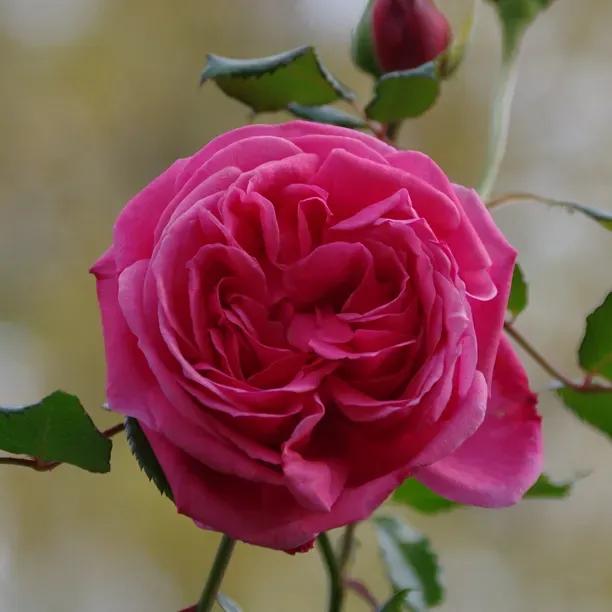Sandringham Rose Bushes
The details
- Type: Shrub
- Colour: Rich pink
- Flower shape: Medium size, double
- Scent: Strong
- Bushy to 150cm x 200cm
- Repeats in flushes June-November with August break.
- Disease resistance: Good
Recommended extras
Description
Rosa Sandringham Shrub Rose Bushes. 4 Litre Pots
A versatile shrub rose with fully double, strongly-scented, rich pink blooms in two main waves, dying down in midsummer. Its size and lovely healthy, glossy mid-green foliage, is ideal for hedging and the back of a border. It can be trained as a low climber.
Browse our other shrub roses, or all our rose varieties.
Features:
- Type: Shrub
- Colour: Rich pink
- Flower shape: Medium size, double
- Scent: Strong
- Bushy to 150cm x 200cm
- Repeats in flushes June-November with August break
- Disease resistance: Good
Growing Sandringham Roses
Good, well drained soil in a sheltered, sunny spot is ideal, but it will tolerate some shade well.
In Your Garden Design
A classic, rich-pink bloomed shrub rose that would look good in any size of garden, small or large. It can even be used a small climber adding interest to a wall. Vita Sackville-West wrote about shrub roses, "One has huge lumps of, let us say, shrub roses making large voluminous bushes like a Victorian crinoline, or flinging themselves about in wild sprays and seem to demand a contrast in a tall sharp plant for example delphiniums". Eremerus would be an equally good combination or the striking leaves of melianthus major would be a good contrast.
Did You Know?
Bred in by Peter Beales (1936-2013), it was one of the last roses he worked on. One parent is the robust Mme Isaac Pereire, and Sandringham has been compared favourably as a direct upgrade to her. Its rose registration code is registration code BEAmolly. Any registration code for a rose beginning with BEA will apply to the magnificent Peter Beale roses. Peter Beale was, in his time, a wonderfully popular figure at the RHS Chelsea Flower Show and his legend lives on in his plants.
At the annual Sandringham Flower Show in 2014 the Prince of Wales and the Duchess of Cornwall were presented with a choice of three new seedlings from Peter Beale's nursery in Norfolk, and they chose ‘BeaMolly’ to be officially named Sandringham after the Royal residence in Norfolk.
Planting Instructions
How to plant Modern Shrub Roses
You can order bareroot roses for delivery from November to March. Containerised plants are available year round.
Soak your roses' roots or pots for a little while before planting. This is an opportunity to prune the stems down to six to ten inches, and inspect the roots to trim off damaged ones.
Choose a spot with reasonable light: semi-shade will do, but full shade will not. Prepare the soil by breaking it up with a fork while removing roots, stones, etc.
- On dry, sandy and chalky soil, dig a big hole, then backfill it with a soil mix improved with three quarters organic material, including compost and manure for fertility, and leafmould or our Rocket Gro soil improver for water retention.
- On good garden soil, adding some organic material is beneficial, especially manure. Dig a shallow hole, deep enough to allow the graft/union to settle right at soil level, and wider than the roots.
- On really heavy clay, which rose roots love, you do not need to dig: slit planting is good, and you can use organic material as a mulch on top.
Spread some Rootgrow mycorrhizal fungi around the bottom of the hole, where it will make contact with the roots.
Arrange a mound on the floor of the hole to set your rose's roots on, so they spread out, and the graft-union is slightly above soil level. Backfill the hole with the planting mix, firming it down as you go, at first with your hand to fix the rose in place, and then with your heel to firm it. Dust some bonemeal on the surface and water in thoroughly. In the process, the soil will settle down so that the graft is clear of the soil.
How to prepare and plant a bareroot rose Video.
Mulch well in spring, and keep well watered during dry periods for the first year. Deadhead repeating roses to encourage continuous flowering.
Newly planted roses shouldn't need much rose food, maybe a dash on poor dry soils. When they are settled in the second year onwards, feed them during the growing season with homemade compost teas and foraged sea weed, or some of our Neudorff rose food.
Mature shrub roses need gentle pruning compared to floribundas and hybrid teas. Prune to tidy the shape in winter. First remove the usual dead, diseased and badly positioned wood, ideally cutting out whole shoots back to a main stem, or outward facing bud. Then remove the wispiest stems, and some of the oldest wood from the centre.


